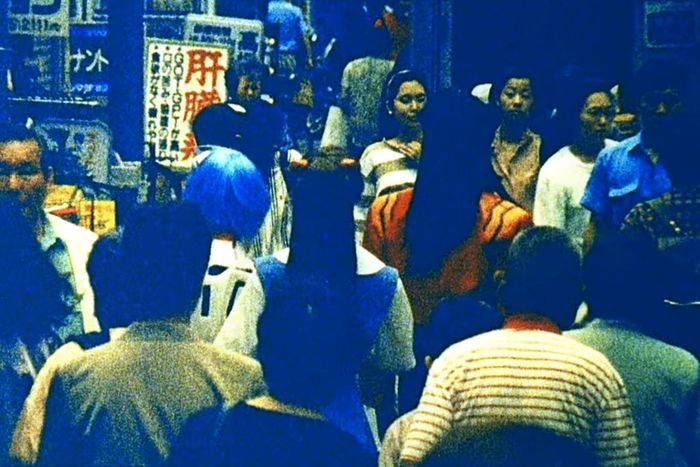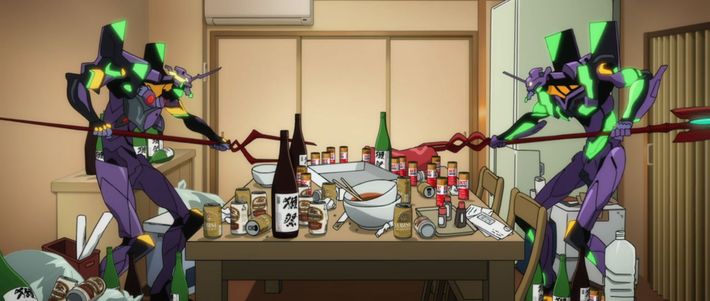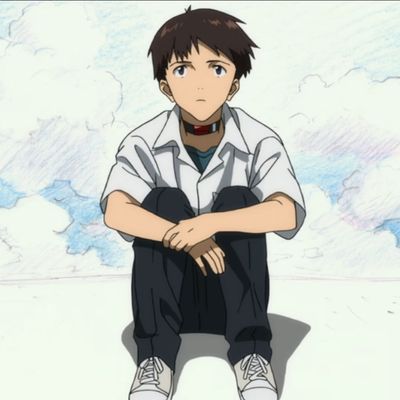
A little over two hours into Evangelion: 3.0+1.0 Thrice Upon a Time, we finally hear Gendo Ikari, father to our protagonist and the anime series’ final boss, speak at length. Unlike his past comeuppances in the expansive Evangelion franchise, here, the man both physically fights his teenage son Shinji and monologues, unleashing heartache over his dead wife, Yui, and taking responsibility for his failures as a dad — failures that have led to a psychosexual apocalypse by which all of humanity liquefies into homogeneous goo.
To longtime Eva fans, Gendo explaining himself feels monumental. But even if you’re unfamiliar with the original mecha show Neon Genesis Evangelion, its follow-up films, or the Rebuild tetralogy that Thrice Upon a Time ties off — all of which remake and remix the same essential story — the monologue arrives with heft. This is the moment director Hideaki Anno chooses to dramatically shift the visual storytelling: “It is a very restful world, where I can be with Yui again,” Gendo says, explaining to his son why he attempted to create a cataclysm where billions of people’s minds would meld into one. The second he utters the line, the crisp, color-saturated, 2-D animation (aided by CGI, of course) that we’ve been watching for two hours cuts to sketchy, rough-hewn line work, closer to storyboards or manga than to finished animation. The choppy editing matches Gendo’s mania and sadness as he recalls his doomed romance, the images gradually overlaid with black-and-white shots of Rei, the girl Gendo created as a replacement for Yui. When Shinji speaks to him, the animation returns to normal, then it cuts back to sketches and shifting backgrounds, as we dive through Gendo’s memories again.
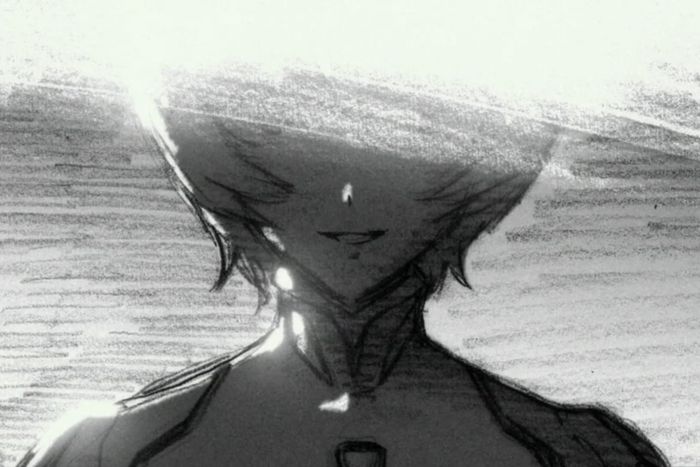
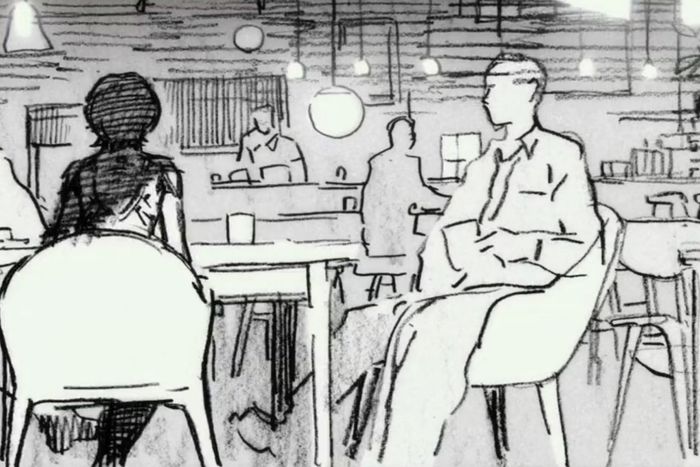
The shifting of animation styles to convey climactic moments in a story is a tale as old as time, but in the Evangelion saga, it has a specific history. Anno famously went over budget on his ’90s TV show, which included a pair of avant-garde final episodes that narrate the characters’ thoughts in clip-show-style, first-person vignettes, rather than depict a straightforward (and more expensive) giant-robot battle. At one point, protagonist Shinji dwells on his loneliness amid a deliriously edited rush of live-action stills, distorted frames of his own face, and other character frames from the show, which eventually get inscribed inside a monochrome illustration of Shinji himself. Without the company of others, the show tells us, Shinji feels literally empty.
Anno equally famously included a trippy live-action sequence at the end of the 1997 follow-up film The End of Evangelion, complete with footage of an audience watching Evangelion in a theater and “fan” reactions to the divisive project. (The “fan” letters that flash across the screen in The End of Evangelion are not all death threats, as some have come to believe; in fact, they’re not even fan letters. They were created by production staff to resemble the kinds of mail Anno received, some of which included death threats.) So when Thrice Upon a Time slides into rough pencils — or stages a scene with its characters in a dark room, watching old clips from Neon Genesis on a projector — Anno is plugging back into familiar territory, excavating his character’s emotions by deconstructing the animation around them.
It was during the production on Neon Genesis that Anno first confronted his own psyche and history of depression, a self-discovery that clearly informed how he drilled into his animated characters’ minds. As early as 1995, Anno, known for sleeping in his office, wrote that he “tried to include everything of myself in Neon Genesis Evangelion.” Twenty years later, he would remark in interviews that, after the lukewarm 2012 reception to his third Evangelion Rebuild film, “I was broken. I fell into what’s called a depressive state, the natural result of having spent six years grinding down my soul making Eva again.” He has also discussed having had suicidal ideation in the ’90s after reading online threads from trolls who suggested ways to end his life.
Ascribing too much autobiography to Anno’s work would be reductive, but his artistic choices routinely break the fourth wall to reveal a closeness to his family of characters. The last images that flash onscreen in the TV series are a written message: “Thank you, Father. Goodbye, Mother. And to all the children: Congratulations.” It could be interpreted as a message from Shinji, or as gratitude in the voice of Shinji’s creator — or both. In The End of Evangelion, made with more resources as a second chance to conclude his cataclysmic saga, Anno gave his yearning fans a final, Earth-shattering kaiju showdown, but the third act also segues into a dreamlike live-action sequence involving actors dressed as Evangelion’s characters, preceded by jarringly edited sequences of scribbled crayon, lovemaking, shouting matches, and domestic abuse. We have no way of knowing Anno’s mind, but Evangelion has in many ways been its canvas and its crucible.
It’s hard to argue that the surreal finales that predate Thrice Upon a Time haven’t felt grim or at least opaque, even when the characters found their way out of darkness. But 3.0 + 1.0 seems to come from a different place. Its defining thematic quote is a series of words — “Good night. Good morning. Thank you. Goodbye.” — which evoke both finality and progress. It’s a farewell, but it’s also a promise that these characters will carry something forward. Whereas The End of Evangelion’s concluding stills raced along the screen into a live-action sequence that arrived with little to no onscreen or in-universe explanation, when Thrice Upon a Time knocks down its fourth wall, the path to closure can feel downright joyous.
For example, the new film still features plenty of indulgently executed kaiju fighting, yet it manages to poke fun at the labor that goes into filmmaking too. Unlike in the other Evangelion films, Gendo Ikari pilots his own version of the iconic purple-and-green Unit 01, and squares off directly against his son. The fight is happening physically, but it also plays out as a psychic duel between the two in a virtual environment. At one point, two kaiju-sized Evangelion Unit 01s battle each other in an animated city intended to hearken back to the the TV show’s fight sequences set in Tokyo-3. Specific shots, like the ground-level view of the pounding foot of Unit 01, are fully re-created frame by frame. As the Evas go at it, the fight knocks one of them straight into an animated vinyl background similar to the ones used in the production of actual, live-action kaiju films. Then the two giant robots are suddenly human-sized and the fight has moved to Shinji’s apartment, framed and colored almost exactly as it looked in the TV series and past films, even though in the franchise’s timeline, the apartment was likely leveled long ago. Soon enough, the characters knock down the apartment walls to reveal an animated version of a live-action soundstage, complete with lighting equipment and wooden backgrounds for Shinji’s apartment. And on the floors? Cameras modified with PlayStation 4 controllers, the same kind shown to be used by Anno’s production team at his studio, Khara, in the documentary Hideaki Anno: The Final Challenge of Evangelion.
The cumulative result of all this inventive intercutting is a nostalgic reminder of everything that makes Evangelion not just psychologically complex, but balls-to-the-wall fun. It recognizes that Evangelion is both a cerebral meta-narrative and a mecha action anime. That action is what hooked fans on Anno’s show in the first place, and the effort to nod at the labor — the rewriting, the nitpicking, all results of Anno’s ceaseless perfectionism — that produced it is a celebration. If the final acts of the TV series and End of Evangelion feel like they were made by a man staring down the meat grinder of depression, the third act of Thrice Upon a Time feels stuffed with new ideas and aspirations. This ending reconciles past versions of Evangelion with a new, fresh context, while also giving characters like Gendo and Shinji the closure they never experienced in the past. As the final act winds down, Shinji recounts how his friends have found new ways to live in their new world. Cycling once again through characters’ minds, he returns to an animated soundstage and shuts a garage door on it, both the characters and the viewers closing out their stories.
As of now Anno has no plans to revisit Evangelion, telling Collider that felt he “very peaceful” after ending the series where he did. For perhaps the first time, so does his protagonist. In one of its final scenes, Shinji sits quietly on a beach as waves lap against the shore. The shot is a mirror image of the red waves from The End of Evangelion, but here, they’re a pristine blue. We cut back to look at Shinji, and the background behind him is now rendered in dashed-off blue pencil. Cut back to the waves, still lazily lapping, but entirely in pencil. Back to Shinji, now entirely in pencil. After more back and forth, we even see artists’ notes on the sketches, before one last Evangelion rises from the water, and Mari, another Eva pilot leaps forward. We’re left in full color.
Anno’s final annihilation comes in Thrice Upon a Time’s last cut. An animated Shinji and Mari — now adults — race up the stairs of a train station. As they exit the station, it cuts to a live-action aerial drone shot that reveals their location to be a station in Ube, where Anno grew up. But if you look closely, you’ll notice that all the characters on the platform are animated.



